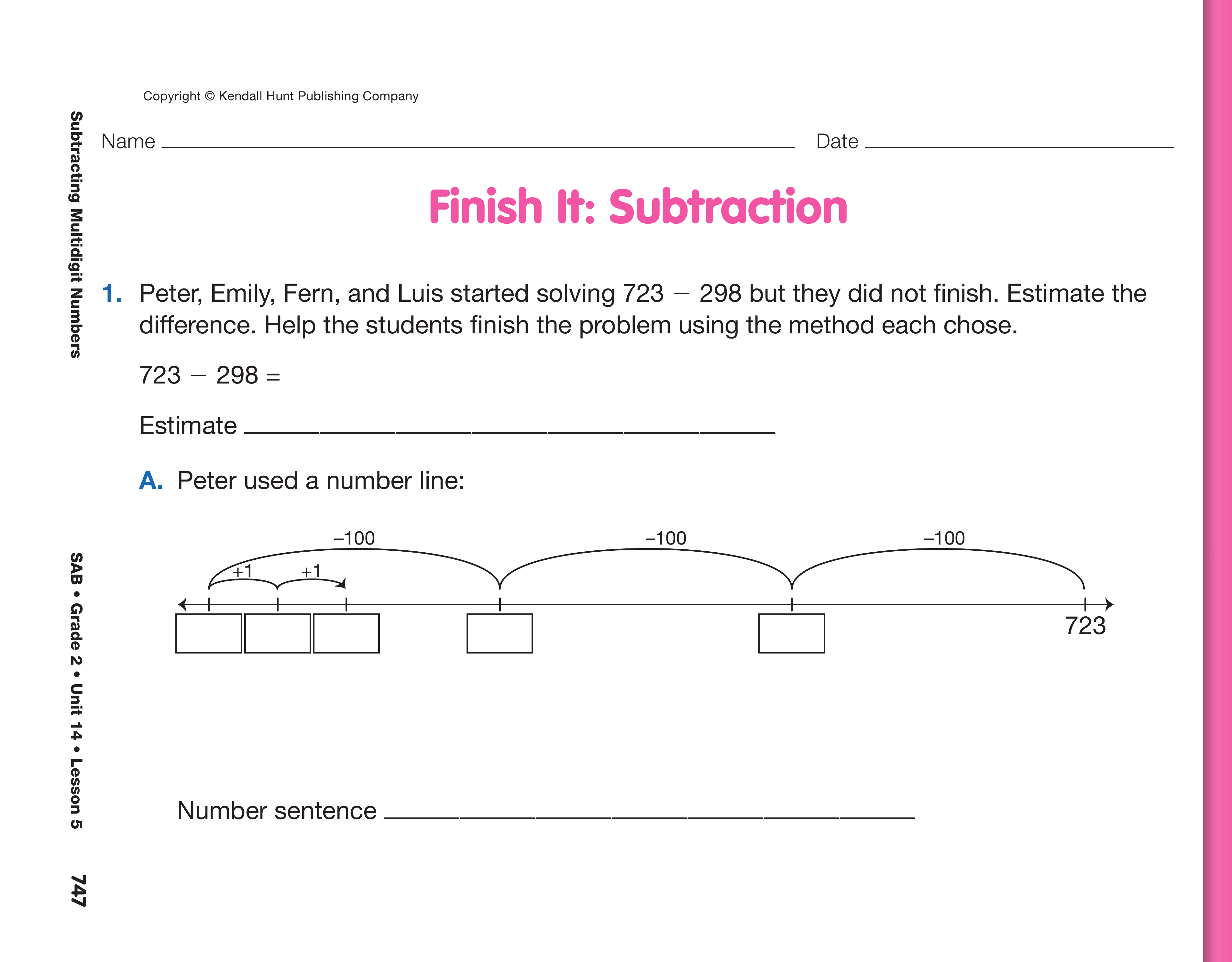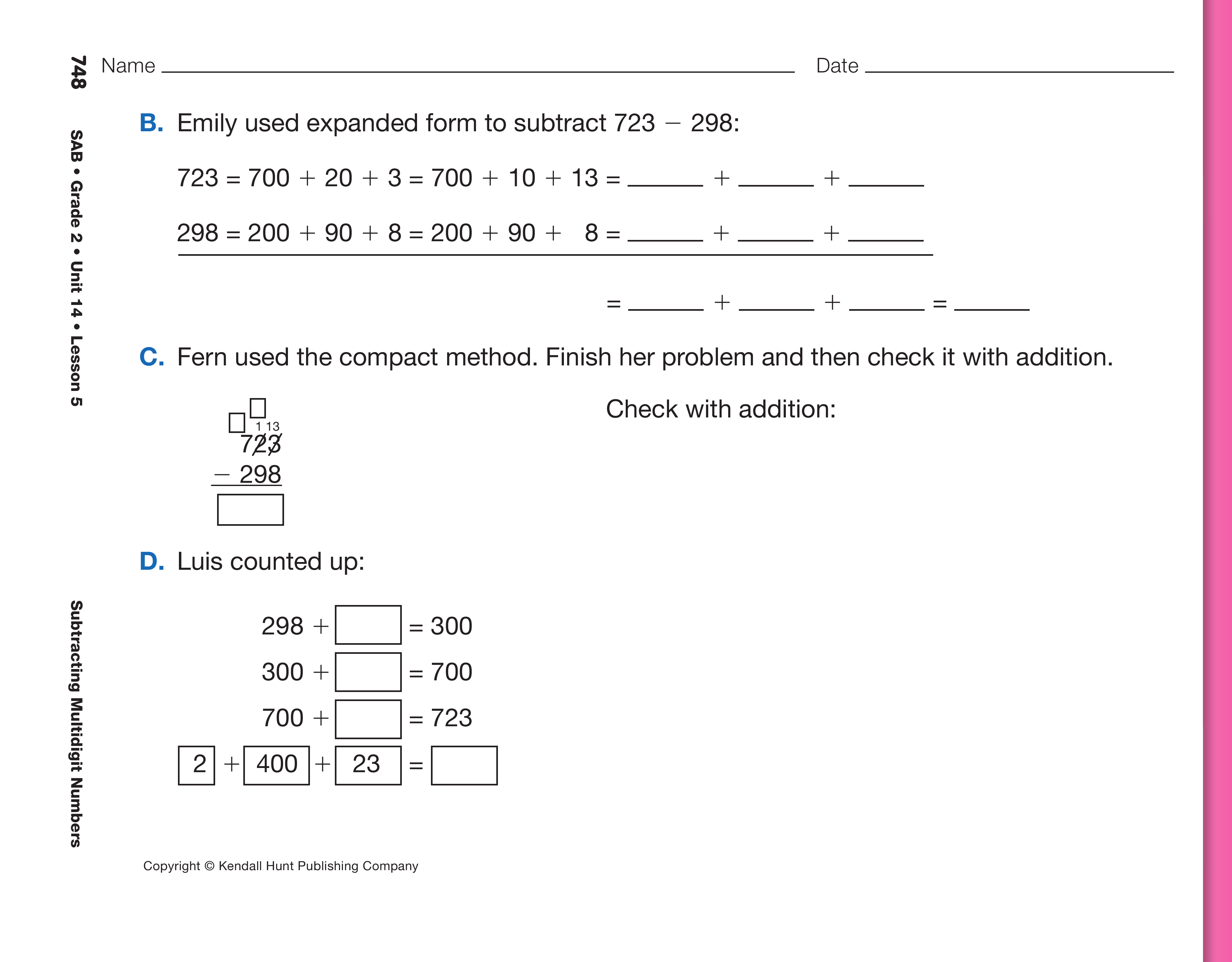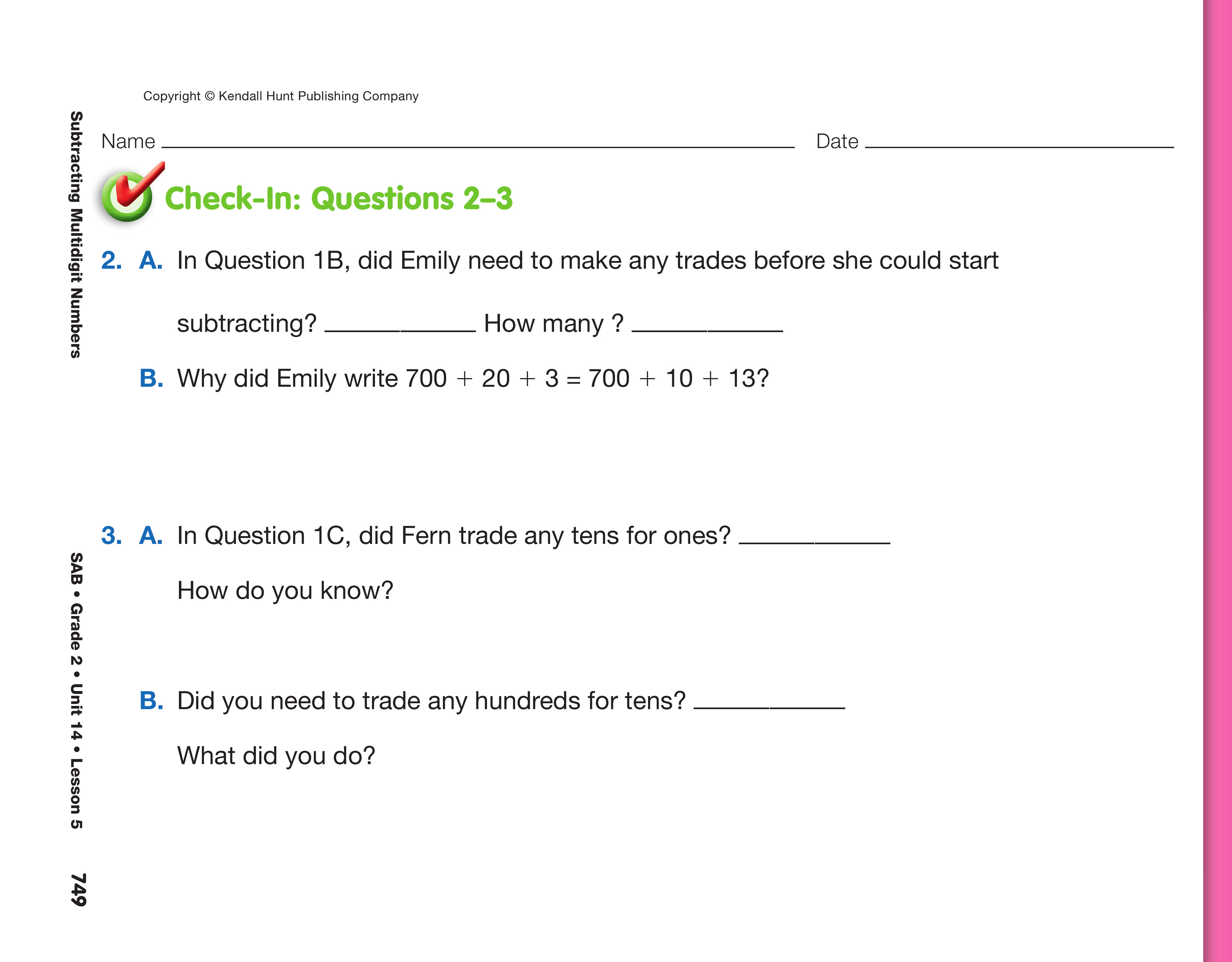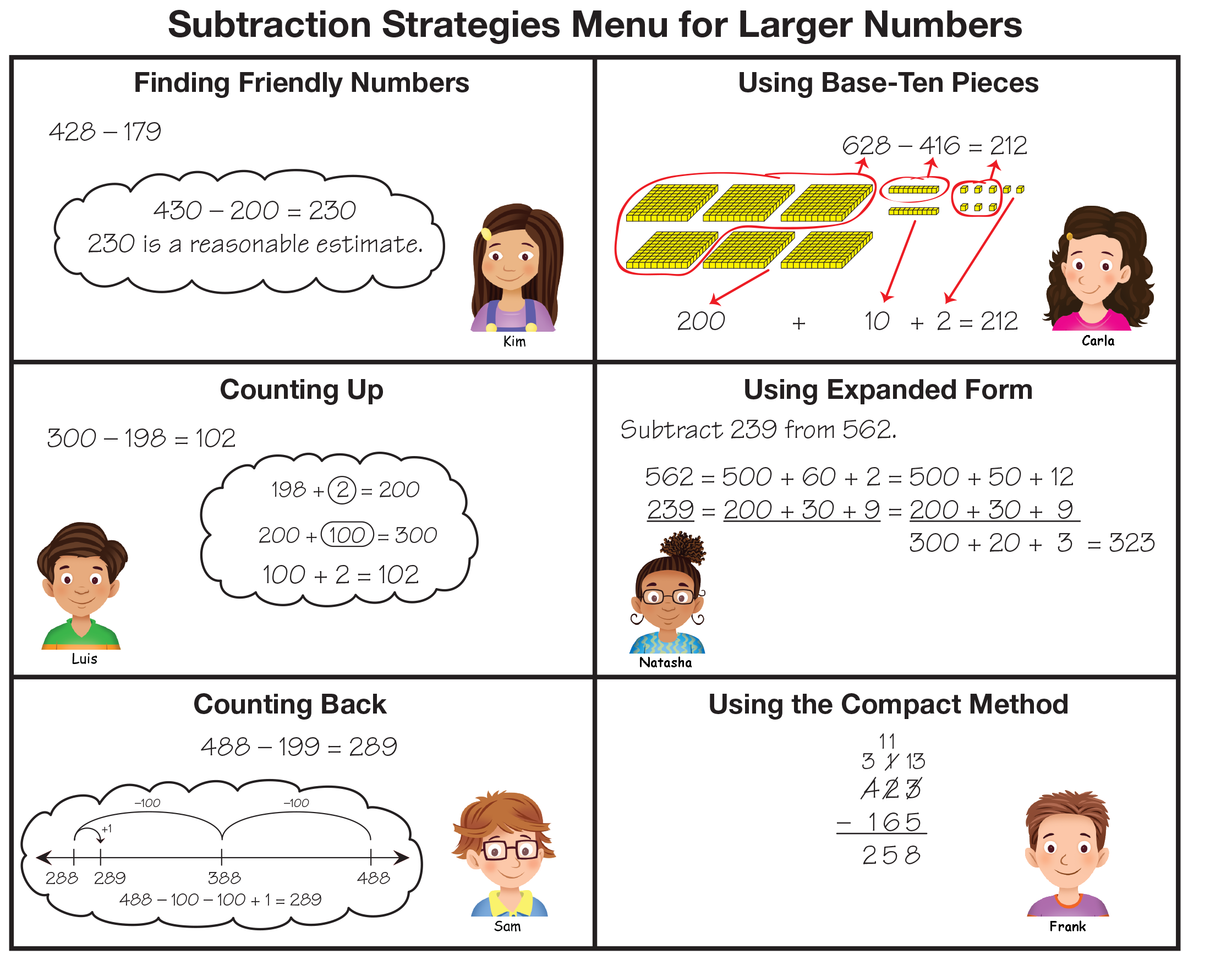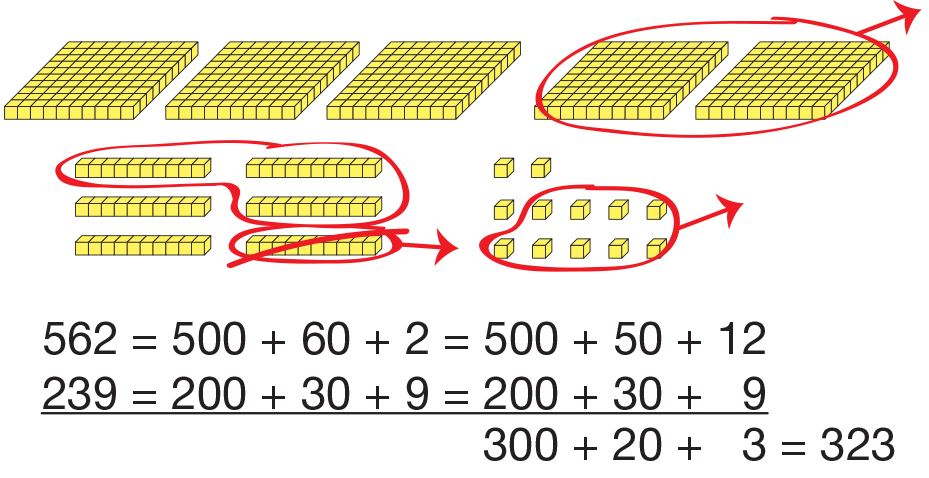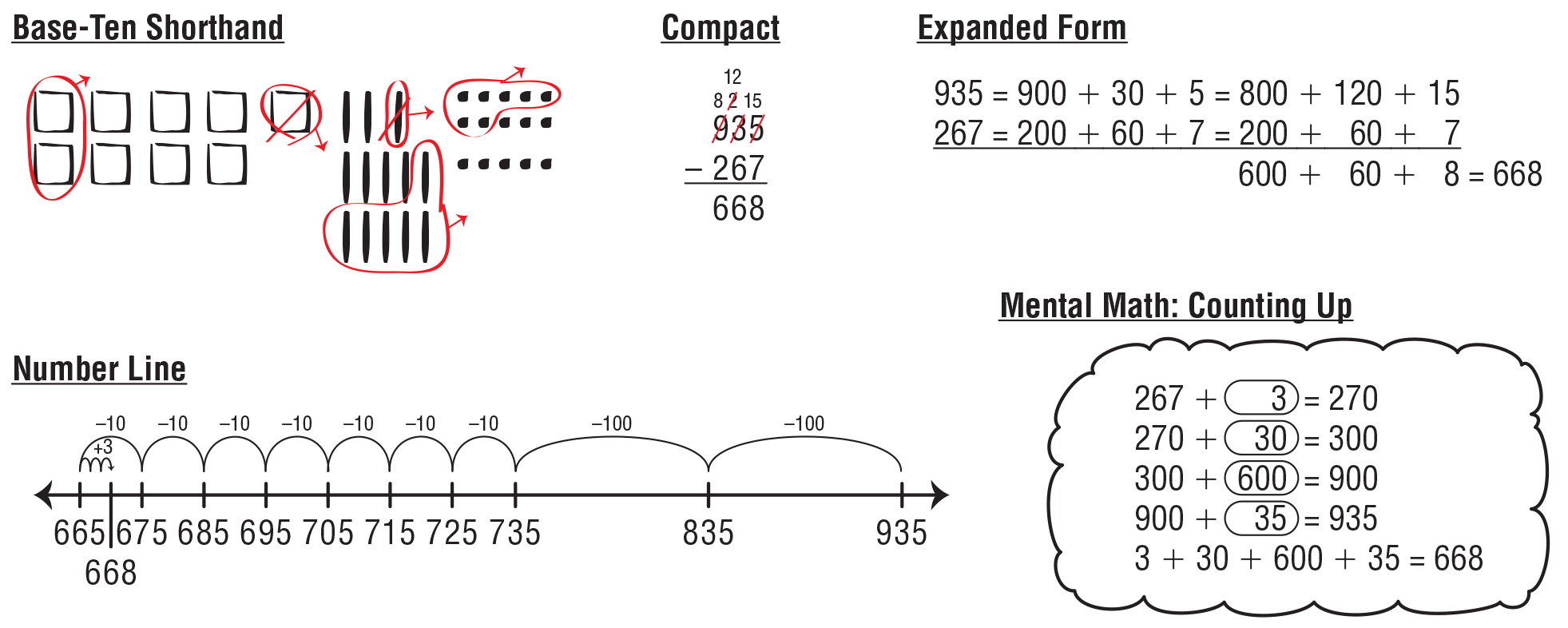Use Base-Ten Pieces. Distribute base-ten pieces to
students to solve the problem 562 − 239. When modeling
subtraction, ask students to place the first number
in the problem, the minuend, 562. They will
show the subtraction by taking away pieces that represent
the second number, the subtrahend, 239. As
students work with the base-ten pieces, be sure they
do not begin the problem by laying out the pieces for
both numbers.
Ask questions similar to the following
that make connections between the base-ten pieces
and the symbols in the numbers:
- How did you model 562? (5 flats, 6 skinnies, and
2 bits)
- If you had a group of 562 things, could you take
239 things away? (yes)
- If you had a group of 239 things, could you take
562 things away? (no)
- Which number is greater, 562 or 239? (562)
- How do you know? (Possible response: 562 has
5 flats or 5 hundreds and 239 has only 2 flats or
2 hundreds so 562 is greater than 239.)
- Which of your pieces represents 60? How do you
know? (the 6 skinnies; each skinny is a ten so 10,
20, 30, 40, 50, 60)
- Which digit has a value of 500? How do you know? (the 5, because it is in the hundreds place)
- How did you represent 500? (5 flats) And 2? (2 bits)
- Think about the numbers 562 and 239 and the
base-ten pieces that represent the numbers. Is
there a big difference between the two numbers? A
little difference? Why do you think so?
- What strategies can you use to estimate the difference? (Possible response: If I just look at the
hundreds, 500 − 200 is 300.)
- Is there another way to estimate the difference?
Explain your strategy.
Remind students that in Lesson 4 they used some of
the following strategies to estimate differences:
- Using Friendly Numbers (changing only
one number, usually the number to be subtracted)
- Using Friendly Numbers (nearest hundred)
- Using Friendly Numbers (nearest ten)
- Subtracting Hundreds
- Counting Back on the Number Line
- Thinking Base-Ten Pieces
Regroup Using Expanded Form. Display and
direct students' attention to the Subtraction
Strategies Menu for Larger Numbers page in the
Student Activity Book Reference section. See Figure 1.
Continue to discuss the same problem,
562 − 239, asking students to relate the base-ten
pieces to the problem written in expanded form on
the menu. See Figure 2.
Remind students that this is a subtraction problem.
The plus signs in the problem written this way simply
refer to the different ways of partitioning the
numbers. This doesn't change it from a subtraction
problem. See the Content Note. Draw students'
attention to the way the columns are aligned in this
notation so that hundreds are subtracted from hundreds,
tens are subtracted from tens, and ones are
subtracted from ones.
We intentionally left the subtraction sign out of the expanded
form solution to the problem. Including it only on the left
would make a mathematically incorrect sentence. A correct
sentence would be − 623 = −(600 + 20 + 3), but students
haven't worked with parentheses yet, so this would be
confusing. If students become confused by the presence of
the plus signs in a subtraction problem, try writing the
expanded form like this:
864 = 800 and 60 and 4
623 = 600 and 20 and 3
200 and 40 and 1 = 241
With each student still modeling 562 with base-ten
pieces, ask:
- How does the problem written this way relate to
the base-ten pieces? How is the 500 + 60 + 2
shown in your base-ten pieces? (That is what I
am starting with: 5 flats, 6 skinnies, and 2 bits.)
- What does the 200 + 30 + 9 in the example on the
menu stand for? (That is what I need to take
away, 239.)
- Can you start subtracting right away? Can you
take 9 bits from 2 bits? (No, I need to make a
trade.)
- What will you trade? (1 skinny for 10 bits or 1 ten
for 10 ones)
- Trade 1 skinny for 10 bits. How many skinnies do
you have now? (5 skinnies) How many bits?
(12 bits)
- How is trading one skinny (1 ten) for ten bits
(10 ones) shown in the expanded form example on
the menu? (Natasha rewrites 60 + 2 as 50 + 12.)
- Does 500 + 60 + 2 equal 500 + 50 + 12? Do you
still have 562 base-ten pieces? (yes) [See Content
Note.]
- Now can you subtract? Can you take 9 from 12? (yes)

Students frequently do not understand that when they make
trades (or regroup) in order to subtract they are just
partitioning the top number in a different way. It is important
for them to realize that the new representation should have
the same value.
For example: 500 + 60 + 2 = 500 + 50 + 12.
Finish working through the example problem.
Compare the difference on the menu, 323, to the
number of base-ten pieces students show in their
answers.
- How does your answer compare with your estimates?
Does this difference seem reasonable?
Display another problem such as 325 − 146, which
requires two trades. Have the class first estimate the
difference. Then ask students to place 325 pieces.
They will use base-ten pieces to solve the problem,
step-by-step, as a volunteer demonstrates the trading
with display base-ten pieces. You will record the
expanded form notation steps.
- How can I write 325 in expanded form? (300 + 20 + 5)
- How can I write 146 in expanded form? (100 + 40 + 6)
Display the notation:
325 = 300 + 20 + 5
146 = 100 + 40 + 6
- How does 300 + 20 + 5 match with your base-ten
pieces? (It is like the 3 flats, 2 skinnies, and
5 bits we are starting with.)
- Can you begin subtracting right away? Can you
take 6 bits from 5 bits or 4 skinnies from 2 skinnies? (no)
- What can you do? (I can trade 1 skinny for
10 bits.)
Tell students to make the first trade with their base-ten
pieces.
- How many skinnies do you have now after the
trade? (1 skinny) How many bits? (15 bits)
Extend the notation by writing:
325 = 300 + 20 + 5 = 300 + 10 + 15
146 = 100 + 40 + 6 = 100 + 40 + 6
- How did I show in expanded form that you traded 1 skinny
for 10 bits? (You rewrote 300 + 20 + 5 to
read 300 + 10 + 15.)
- What do you notice about this problem? Are you
ready to start subtracting? Can you subtract 6 from 15? (I can subtract 6 from 15, but I can't
subtract 40 from 10.)
- What should you do with your base-ten pieces? (Trade a flat for 10 skinnies.)
Tell students to demonstrate the trade with their
base-ten pieces.
- How many flats do you have left after the trade? (2 flats)
- How many hundreds is that? (2 hundreds)
- How many skinnies do you have now? (11 skinnies)
- How many tens is that? Count by tens. (10, 20, 30,
40, 50, 60, 70, 80, 90, 100, 110)
- Do you still have 15 bits? (yes)
- How should I show these trades in expanded
form? [See below.]
Continue writing the problem in expanded form as
you make connections between the notation and the
base-ten pieces. Write:
325 = 300 + 20 + 5 = 300 + 10 + 15 = 200 + 110 + 15
146 = 100 + 40 + 6 = 100 + 40 + 6 = 100 + 40 + 6
Show the subtraction steps as you remind students to
subtract hundreds from hundreds, tens from tens,
and ones from ones. 200 minus 100 is 100, 110
minus 40 is 70, and 15 minus 6 is 9. Complete the
problem by adding 100 + 70 + 9:
325 = 300 + 20 + 5 = 300 + 10 + 15 = 200 + 110 + 15
146 = 100 + 40 + 6 = 100 + 40 + 6 = 100 + 40 + 6
100 + 70 + 9 = 179
Compare Subtraction Menus. Display the
Subtraction Strategies Menu in the Student Activity
Book Reference section as you direct students to the
new version of the menu, the Subtraction Strategies
Menu for Larger Numbers in the Student Activity
Book Reference section.
- How are these two subtraction menus the same? (The paper-and-pencil strategies and mental math
strategies are the same.)
- How are they different? (Possible responses: On
the new menu, the numbers in the examples are
bigger. They are all 3-digit numbers minus
3-digit numbers. You can't use the 200 Chart to
count up or count back because the numbers are
too big. The examples show a lot of trades.)
- Are you familiar with all of the strategies on the
new Subtraction Strategies Menu for Larger
Numbers?
- How could this menu be helpful to you? (I can use
it when I am solving subtraction problems with
larger numbers.)
Use a Variety of Strategies. Explain that students
are going to use the Subtraction Strategies Menu for
Larger Numbers to solve the same problem in many
different ways so that comparisons can be made. Tell
students to first estimate the difference for
935 − 267. Then ask student pairs to choose a way
to solve the problem. This problem involves
two trades. Guide students toward picking a
strategy they feel confident using.
- Who can solve 935 − 267 using base-ten pieces or
shorthand? a number line? a different mental math
strategy? expanded form? the compact method?
another way?
Give student pairs a piece of chart paper on which to
display their solution strategies. Make sure all of the
strategies are represented. After they solve the problem,
ask students to display their solution strategies.
See Figure 3.
Ask questions that make connections
between the strategies such as:
- How did [student names] show 900? 30? 5?
- How did [student names] show 200? 60? 7?
- How did [student names] show 267 in expanded
form? (200 + 60 + 7)
- On the number line? (2 hops of 100, 6 hops of 10,
and 7 hops of 1)
- Did [student names] make any trades with base
ten pieces? (They traded 1 skinny for 10 bits and
then 1 flat for 10 skinnies.)
- [Student names] used the compact method. How
did they show trades? (When they needed to
trade a skinny for 10 bits, they crossed the number
of skinnies out and wrote one less to show
that one was traded. They wrote the new number
of bits to show they added 10 bits to the number
of bits that were there in the beginning. They did
the same sort of thing when they traded a flat for
10 skinnies.)
- [Student names] solved the problem using
expanded form. Did they need to make any trades
in order to subtract 267 from 935 or could they
start subtracting right away? (They needed to
make some trades.)
- How did [student names] show trades when they
used expanded form? (They kept writing different
partitions for 935.)
- What were some of the different number sentences
[student names] used to show 935? (Possible responses: 900 + 30 + 5, 900 + 20 + 15,
and 800 + 120 + 15)
- Do all of these number sentences represent 935? (yes)
- Did everyone get the same answer? (yes, 668)
- How do the answers compare to your estimate?
Does the answer seem reasonable?
- Does one way seem more efficient than another
when you are subtracting larger numbers? Why? (Possible responses: I don't always have base-ten
pieces, so that's not always an efficient strategy.
There were a lot of numbers to keep straight so
the paper-and-pencil methods seem more efficient.
There was less writing with the compact
method than with expanded form.)
Check Subtraction with Addition. Remind students
that there are many ways to check answers.
Comparing an answer to an estimate is one way to
see if the answer is reasonable. Another way to
check the answer to a problem is to solve the problem
another way. Students demonstrated that by
solving the problem in a variety of ways. Students
can also use addition to check their subtraction calculations.
Review how to add the difference (668) to
what was subtracted, the subtrahend (267), to see if
they get the starting amount, the minuend (935). See
Figure 4. Ask students to use addition to check their
subtraction calculations.
- When you added your answer to the number you
subtracted, did you get the number you started
with, 935?
- Does this make sense? Why or why not? (Possible
response: Yes, it makes sense because subtraction
and addition are like opposites. If you start with
an amount and take some away, you should be
able to add that amount back and have the same
amount.)
Finish It. Assign the Finish It: Subtraction pages in
the Student Activity Book. Students will practice
using a variety of methods to solve 3-digit subtraction
problems and make connections among the
strategies. They will use addition to check their subtraction.
Use Check-In: Questions 2–3 and the Feedback Box on the
Finish It: Subtraction pages in the Student Activity Book to
assess students' abilities to use and apply place value
concepts to make connections among representations of
multidigit numbers [E1]; subtract multidigit numbers using
paper-and-pencil methods [E7]; check for reasonableness
[MPE3]; and check calculations [MPE4].
Upon completion, use the following prompts to discuss
students' work:
- How did you estimate the difference for 723 − 298? (Possible response: I used friendly numbers.
700 − 300 is 400.)
- Model the problem with base-ten pieces and solve
it. What is your answer? (425)
- How does this answer compare to your estimate?
Is your answer reasonable?
- Show how to check the problem using addition. (425 + 298 = 723)
- Look at Emily's work with expanded form in
Question 1B. Explain the trades that were made. [See Figure 5.] (Two trades were made. She could
not take 8 from 3. She needed to take 10 from the
20 to give the 3 ten more ones. 9 tens could not
be taken from 1 ten, so 1 hundred was traded for
10 tens.)
- Look at Fern's work with the compact method in
Question 1C. Explain the trades that were made. [See Figure 6.] (The 2 is crossed out to show that
1 ten was taken from the 20 and 10 was left after
the trade. A little 13 in the ones column shows
that there were 13 ones after the trade. The 7 is
crossed out to show that 1 hundred was taken
from the 700 and the 6 shows that 600 was left
after the trade. A little 11 in the tens column
shows that there were 11 tens after the trade.)
- Which strategy did you like the best? Why?















